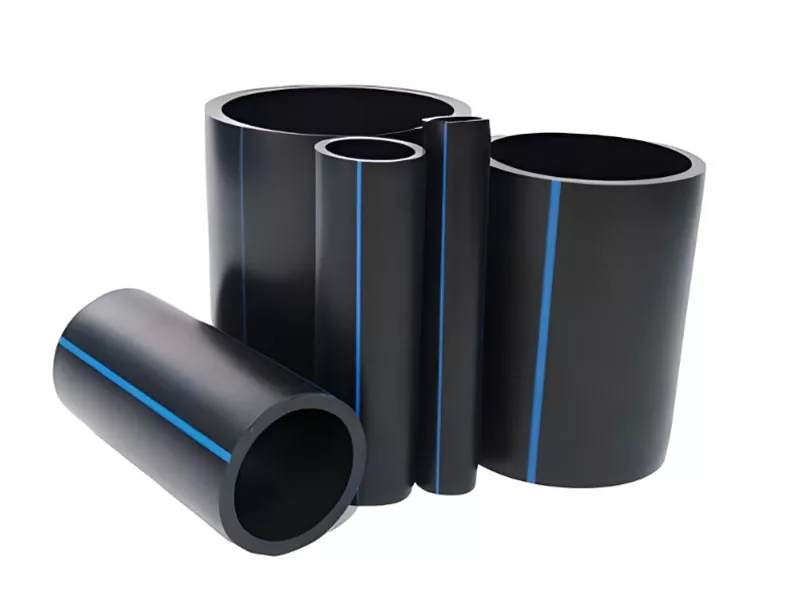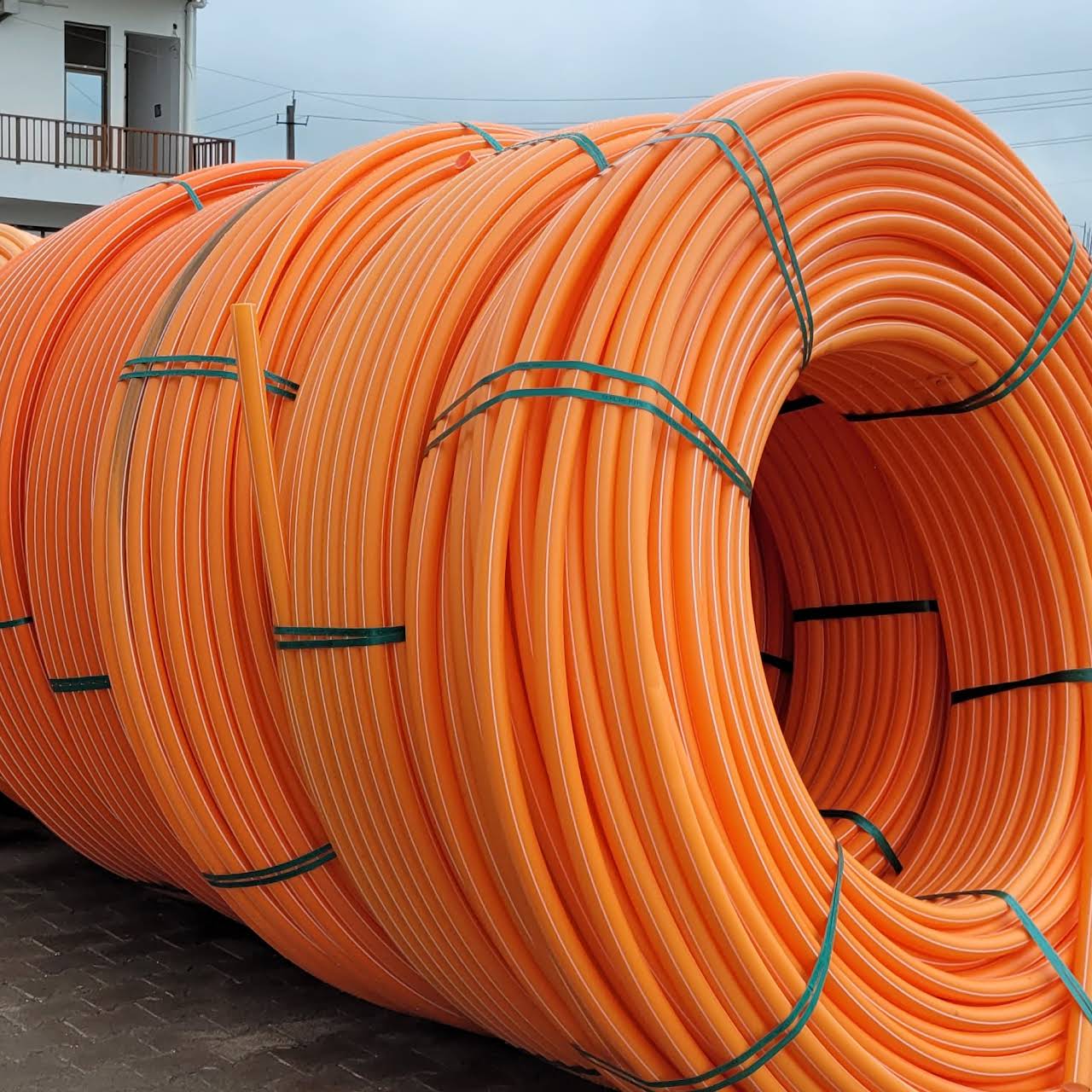Why Partnering with Pipe Supplier American Plastics Midland Ensures Timely Supply
Check Out the Manufacturing Process Behind High-Quality HDPE Pipe and Its Applications
The manufacturing process of top quality HDPE pipelines is elaborate and systematic. It starts with the selection of resources that boost efficiency. Following this, ethylene goes through polymerization to create material, which is then shaped via extrusion. Quality control is paramount, making sure that the last product satisfies rigorous standards. Nonetheless, the journey of HDPE pipelines doesn't finish with production. Their applications across numerous sectors disclose a more comprehensive relevance worth checking out.
Comprehending HDPE: Characteristics and Advantages

High-density polyethylene (HDPE) is a versatile thermoplastic known for its resilience and resistance to various environmental variables. This product shows superb tensile stamina, making it suitable for requiring applications. Its low-density structure adds to a light-weight item, promoting ease of handling and setup. HDPE also showcases remarkable resistance to chemicals, which minimizes deterioration when revealed to rough substances.
The product's low dampness absorption even more boosts its longevity, making it excellent for use in pipelines and storage space containers. In addition, HDPE is immune to ultraviolet (UV) radiation, guaranteeing that items maintain their integrity even when revealed to sunlight. Its versatility allows for the production of detailed forms without endangering strength. The green nature of HDPE, commonly derived from recycled products, includes in its appeal, promoting lasting techniques in production. On the whole, these homes and advantages make HDPE a preferred selection for various commercial and consumer applications.
Raw Product Option for HDPE Production
The option of basic materials for HDPE manufacturing is vital to confirm the final item fulfills the preferred specs and top quality requirements. High-density polyethylene (HDPE) is largely created from polymerized ethylene, originated from nonrenewable fuel sources such as gas or crude oil. The top quality of these feedstocks substantially influences the mechanical and thermal properties of the final HDPE.
Additives likewise play a considerable function in boosting HDPE's performance, including antioxidants, UV stabilizers, and colorants, which improve resilience and resistance to ecological factors. The choice process must take into consideration not only the chemical composition of the raw materials however also their processing attributes to ensure effective production.
Furthermore, the sourcing of basic materials must focus on sustainability and compliance with ecological guidelines, as responsible techniques are crucial in today's market. Inevitably, cautious resources option lays the structure for creating premium HDPE pipelines suitable for diverse applications.
The Extrusion Process: Forming HDPE Pipe
The extrusion process plays an important function in shaping HDPE pipelines, beginning with careful material prep work techniques that assure ideal flow and uniformity. Just as vital is the layout of the die, which straight influences the last measurements and surface high quality of the pipe. With each other, these factors add substantially to the effectiveness and top quality of HDPE pipe production.
Material Prep Work Techniques
Effective manufacturing of HDPE pipes begins with thorough product preparation methods, especially the extrusion process. Throughout this phase, high-density polyethylene material is initial dried out to remove dampness, making sure suitable flow features. The material is after that fed right into the extruder, where it undertakes heating and melting, changing into a viscous state. This heating process is carefully regulated to maintain the product's honesty and performance. The liquified HDPE is forced with a die, forming it into a constant pipeline type. Appropriate temperature level management during extrusion is crucial, as it straight impacts the product's properties and the last product top quality. As soon as formed, the HDPE pipe is cooled and reduced to defined sizes, all set for succeeding handling and applications.
Die Style Value
Accuracy in die layout plays an essential role in the extrusion process of HDPE pipelines. The die works as the final shaping tool, straight affecting the pipe's measurements, wall thickness, and surface coating. A properly designed die guarantees consistent material circulation, decreasing flaws such as irregularities and weak points. The geometry of the die must be optimized to suit the details residential properties of HDPE, including its thickness and thermal behavior throughout extrusion. Additionally, the cooling price of the material as it travels through the die can markedly influence the pipeline's structural honesty. Spending in advanced die modern technology is important for suppliers intending to generate top notch HDPE pipelines that satisfy market standards and client assumptions.
High Quality Control Actions in HDPE Production
Although numerous variables affect the high quality of HDPE pipeline manufacturing, reliable quality assurance actions are crucial to ensure uniformity and integrity in the last item. Key quality control methods include rigorous material evaluation, confirming that the raw polyethylene fulfills recognized standards for pureness learn the facts here now and density. Throughout the extrusion process, parameters such as temperature level, stress, and cooling time are closely checked to keep dimensional precision and structural stability
Furthermore, post-production testing is vital; manufacturers frequently perform hydrostatic examinations to examine the pipeline's strength and resistance to stress. Visual inspections for surface area flaws better enhance high quality assurance. Accreditation from pertinent criteria companies, like ASTM or ISO, gives an additional layer of reputation. By applying these complete top quality control steps, suppliers can decrease problems, boost performance, and guarantee that the HDPE pipes fulfill the details requirements of different applications, ultimately leading to customer complete satisfaction and depend on in the product.
Applications of HDPE Pipeline Throughout Industries
HDPE pipelines are used across various sectors due to their sturdiness and convenience. In water circulation systems, they ensure reliable distribution, while in wastewater management, they provide trusted solutions for waste transportation. In addition, agricultural watering networks profit from HDPE's resistance to corrosion and adaptability, making it an ideal selection for contemporary farming methods.

Water Distribution Equipments
A substantial variety of industries depend on high-density polyethylene (HDPE) pipelines for efficient water circulation systems. Recognized for their toughness and resistance to corrosion, HDPE pipelines are commonly made use of in local water supply networks, agricultural irrigation, and commercial applications. Their lightweight nature helps with very easy handling and installment, decreasing labor prices and time. Additionally, HDPE pipes can fit various pressure levels, making them suitable for both low and high-pressure systems. custom hdpe pipe manufacturing Midland TX. The adaptability of the material allows for smooth integration right into existing framework, lessening the requirement for substantial excavation. HDPE's resistance to chemical seeping warranties that the water supplied stays secure and clean, making it an ideal option for maintaining the high quality of drinkable water across numerous markets.
Wastewater Monitoring Solutions
Efficient water distribution systems also lead the method for cutting-edge wastewater monitoring services, where high-density polyethylene (HDPE) pipes play a significant duty. Distinguished for their durability and resistance to deterioration, HDPE pipes are ideal for transferring wastewater in numerous settings. Their flexibility enables for easy setup in intricate atmospheres, minimizing the need for extensive excavation. Additionally, HDPE's smooth interior surface reduces rubbing, boosting circulation prices and performance. These pipelines are also immune to chemical leaching, ensuring that contaminants do not endanger the surrounding environment. Industries, communities, this page and therapy centers increasingly count on HDPE pipelines for their dependability and longevity, making them a favored choice for contemporary wastewater monitoring systems. This adaptability highlights the essential relevance of HDPE pipelines across countless applications.
Agricultural Irrigation Networks
Agricultural watering networks benefit significantly from the usage of high-density polyethylene (HDPE) pipes, which give reliable and trusted water shipment to crops. HDPE pipelines are lightweight, making them very easy to transfer and install, while their versatility enables numerous configurations in varied terrains. These pipelines demonstrate superb resistance to corrosion, chemicals, and UV radiation, ensuring toughness in harsh agricultural settings. Furthermore, their smooth indoor surface area decreases rubbing loss, maximizing water flow and lowering power expenses related to pumping. The long life of HDPE pipes, typically surpassing half a century, contributes to lower maintenance and substitute costs. Farmers significantly depend on HDPE pipelines to enhance watering performance and advertise lasting agricultural practices, inevitably leading to enhanced crop yields and source conservation.

Future Patterns in HDPE Pipeline Innovation
As the need for lasting and effective infrastructure expands, developments in HDPE pipe technology are positioned to change various markets. Emerging trends consist of the assimilation of wise innovations, such as sensing units and IoT capacities, which promote real-time tracking of pipeline conditions, reducing upkeep prices and avoiding leakages. Additionally, the growth of innovative manufacturing methods, such as 3D printing, is making it possible for the production of complicated, personalized pipeline designs that satisfy particular job needs.
In addition, the focus on recycling and circular economic climate methods is driving the technology of HDPE pipelines made page from recycled products, boosting sustainability. Improved jointing techniques, such as electro-fusion and mechanical installations, are likewise enhancing setup efficiency and reliability. Ultimately, the growing focus on ecological regulations is pressing suppliers to take on greener production processes, ensuring that HDPE pipelines not only meet market standards however likewise promote an even more sustainable future for framework advancement.
Frequently Asked Inquiries
Just How Does HDPE Compare to Other Plastic Materials?
HDPE outperforms several various other plastic products concerning durability, chemical resistance, and adaptability. Its low thickness and high tensile toughness make it optimal for various applications, usually surpassing options in both performance and durability.
What Are the Ecological Effects of HDPE Manufacturing?
The environmental effects of HDPE manufacturing consist of greenhouse gas discharges, power consumption, and possible pollution from producing processes. In addition, inappropriate disposal can lead to dirt and water contamination, elevating worries about long-term eco-friendly results.
Can HDPE Piping Be Recycled?
Yes, HDPE pipes can be reused. Numerous centers accept utilized HDPE for handling, transforming it right into brand-new items. This reusing adds to sustainability efforts, decreasing plastic waste while saving sources and power in the production cycle.
What Is the Life-span of HDPE Water Lines?

Just How Do Temperature Variations Influence HDPE Pipeline Performance?
Temperature level variants substantially impact HDPE pipe efficiency, affecting versatility and stamina. Heats can lead to softening, while low temperature levels may trigger brittleness, eventually influencing the pipe's toughness and suitability for different applications in varied atmospheres.